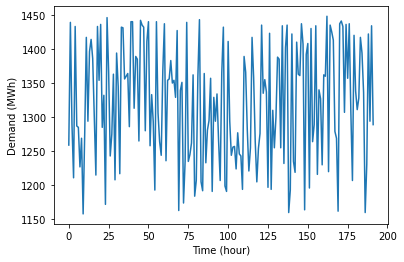
| Star | Watch | Fork |
| Home |
|---|
| User Guide |
| Examples |
| About |
The Unit Commitment Problem
In this example, we attempt to solve a unit commitment (UC) problem described in the tutorial of IBM Decision Optimization CPLEX for Python (DOcplex). The electricity demand data and parameters of all generators are read from the data file uc_data.xlsx, by code segments below.
import pandas as pd
import matplotlib.pyplot as plt
demand = pd.read_excel('uc_data.xlsx', 'Demand') # Electricity demand
plt.plot(demand.index, demand['load'])
plt.xlabel('Time (hour)')
plt.ylabel('Demand (MWh)')
plt.show()
units = pd.read_excel('uc_data.xlsx', 'Units') # Parameters of generators
units

| name | energy | initial | min_gen | ... | start_cost | fixed_cost | variable_cost | co2_cost | |
|---|---|---|---|---|---|---|---|---|---|
| 0 | coal1 | coal | 400 | 100.00 | ... | 5000 | 208.610 | 22.536 | 30 |
| 1 | coal2 | coal | 350 | 140.00 | ... | 4550 | 117.370 | 31.985 | 30 |
| 2 | gas1 | gas | 205 | 78.00 | ... | 1320 | 174.120 | 70.500 | 5 |
| 3 | gas2 | gas | 52 | 52.00 | ... | 1291 | 172.750 | 69.000 | 5 |
| 4 | gas3 | gas | 155 | 54.25 | ... | 1280 | 95.353 | 32.146 | 5 |
| 5 | gas4 | gas | 150 | 39.00 | ... | 1105 | 144.520 | 54.840 | 5 |
| 6 | diesel1 | diesel | 78 | 17.40 | ... | 560 | 54.417 | 40.222 | 15 |
| 7 | diesel2 | diesel | 76 | 15.20 | ... | 554 | 54.551 | 40.522 | 15 |
| 8 | diesel3 | diesel | 0 | 4.00 | ... | 300 | 79.638 | 116.330 | 15 |
| 9 | diesel4 | diesel | 0 | 2.40 | ... | 250 | 16.259 | 76.642 | 15 |
10 rows × 14 columns
Parameters of the UC model are specified by the code segment below,
g_init = units['initial'].values
u_init = (g_init > 0).astype(int)
g_min = units['min_gen'].values
g_max = units['max_gen'].values
h_up = units['min_uptime'].values
h_down = units['min_downtime'].values
r_up = units['ramp_up'].values
r_down = units['ramp_down'].values
a = units['fixed_cost'].values
b = units['variable_cost'].values
c = units['start_cost'].values
d = demand['load'].values
e = units['co2_cost'].values
and detailed information on these parameters is provided in the following table.
| Notation | Interpretation | Array Expression | Python Variable |
|---|---|---|---|
| \(g_n^{\text{init}}\) | The initial output of the \(n\)th generator | units['initial'].values |
g_init |
| \(u_n^{\text{init}}\) | The initial on/off status of the \(n\)th generator | (g_init > 0).astype(int) |
u_init |
| \(g_n^{\text{min}}\) | The minimum capacity of the \(n\)th generator | units['min_gen'].values |
g_min |
| \(g_n^{\text{max}}\) | The maximum capacity of the \(n\)th generator | units['max_gen'].values |
g_max |
| \(h_n^{\text{up}}\) | The minimum up time of the \(n\)th generator | units['min_uptime'].values |
h_up |
| \(h_n^{\text{down}}\) | The minimum down time of the \(n\)th generator | units['min_downtime'].values |
h_down |
| \(r_n^{\text{up}}\) | The ramp-up rate limit of the \(n\)th generator | units['ramp_up'].values |
r_up |
| \(r_n^{\text{down}}\) | The ramp-down rate limit of the \(n\)th generator | units['ramp_down'].values |
r_down |
| \(a_n\) | The fixed cost of the \(n\)th generator | units['fixed_cost'].values |
a |
| \(b_n\) | The variable cost of the \(n\)th generator | units['variable_cost'].values |
b |
| \(c_n\) | The start-up cost of the \(n\)th generator | units['start_cost'].values |
c |
| \(d_t\) | The demand at time step \(t\) | demand['load'].values |
d |
| \(e_t\) | The CO2 emission cost of the \(n\)th generator | units['co2_cost'].values |
e |
The UC model that determines the on/off statues of generators and their outputs in supplying the electricity demand can be written as the following mixed-integer linear programming problem.
\[\begin{align} \min~&\sum\limits_{t=1}^T\sum\limits_{n=1}^N\left(a_nu_{tn} + b_ng_{tn} + c_nv_{tn} + e_ng_{tn}\right) \hspace{-1in}& \\ \text{s.t.}~&v_{1n} \geq u_{1n} - u_n^{\text{init}}, v_{1n} \geq 0 &\forall n= 1, ..., N \\ &v_{tn} \geq u_{tn} - u_{(t-1)u}, v_{tn} \geq 0 & \forall t = 2, ..., T, \forall n = 1, ..., N \\ &w_{1n} \geq u_n^{\text{init}} - u_{1n}, w_{1n} \geq 0 &\forall n= 1, ..., N \\ &w_{tn} \geq u_{(t-1)u} - u_{tn}, w_{tn} \geq 0 & \forall t = 2, ..., T, \forall n = 1, ..., N \\ &\sum\limits_{k=t-h_n^{\text{up}}+1}^tv_{tn} \leq u_{tn} & \forall t=h_n^{\text{up}}, ..., T, \forall n = 1, ..., N \\ &\sum\limits_{k=t-h_n^{\text{down}}+1}^tw_{tn} \leq 1 - u_{tn} & \forall t=h_n^{\text{down}}, ..., T, \forall n = 1, ..., N \\ &\sum\limits_{n=1}^Tg_{tn} = d_{t} &\forall t=1, ..., T \\ &u_{tn}g_n^{\text{min}} \leq g_{tn} \leq u_{tn}g_n^{\text{max}} &\forall t=1, ..., T, \forall n = 1, ..., N \\ &g_{1n} - g_n^{\text{init}} \leq r_n^{\text{up}} &\forall n = 1, ..., N \\ &g_{tn} - g_{(t-1)n} \leq r_n^{\text{up}} &\forall t=2, ..., T, \forall n=1, ..., N \\ &g_n^{\text{init}} - g_{1n} \leq r_n^{\text{down}} &\forall n = 1, ..., N \\ &g_{(t-1)n} - g_{tn} \leq r_n^{\text{down}} &\forall t=2, ..., T, \forall n=1, ..., N \end{align}\]where \(T\) is the number of time steps, and \(N\) is the number of generator units. The decision variables are explained in the following table.
| Notation | Interpretation | Python Variable |
|---|---|---|
| \(u_{tn}\) | Binary variable indicating the status of the \(n\)th generator at time \(t\) |
u |
| \(v_{tn}\) | Binary variable indicating if the \(n\)th generator is switched on at time \(t\) |
v |
| \(w_{tn}\) | Binary variable indicating if the \(n\)th generator is switched off at time \(t\) |
w |
| \(g_{tn}\) | Continuous variable representing the output of the \(n\)th generator at time \(t\) |
g |
The UC model above can be implemented by the following Python code.
from rsome import ro
model = ro.Model('UC') # Create a model named 'UC'
N = units.shape[0] # Number of units
T = len(d) # Number of time steps
u = model.dvar((T, N), 'B') # Unit commitment statuses
v = model.dvar((T, N), 'B') # Switch-on statuses of units
w = model.dvar((T, N), 'B') # Switch-off statuses of units
g = model.dvar((T, N)) # Generation outputs
model.min((a*u + b*g + c*v + e*g).sum()) # Minimize the total cost
model.st(v[0] >= u[0] - u_init,
v[1:] >= u[1:] - u[:-1],
v >= 0) # Switch-on statuses
model.st(w[0] >= u_init - u[0],
w[1:] >= u[:-1] - u[1:],
w >= 0) # Switch-off statuses
for n in range(N):
model.st(v[t-h_up[n]+1:t+1, n].sum() <= u[t, n]
for t in range(h_up[n], T)) # Minimum up time constraints
model.st(w[t-h_down[n]+1:t+1, n].sum() <= 1 - u[t, n]
for t in range(h_down[n], T)) # Minimum down time constraints
model.st(g.sum(axis=1) == d) # Power balance equation
model.st(g >= u*g_min, # Minimum capacities of units
g <= u*g_max) # Maximum capacities of units
model.st(g[1:] - g[:-1] <= r_up,
g[0] - g_init <= r_up, # Ramp-up rate limits
g[:-1] - g[1:] <= r_down,
g_init - g[0] <= r_down) # Ramp-down rate limits
model.solve() # Solve the model
print(f'\nMinimum cost: {model.get():.4f}')
Being solved by the default MILP solver...
Solution status: 0
Running time: 1.4817s
Minimum cost: 14213082.0639
Please note that here we are using the default solver imported from the scipy.optimize to solve the mixed-integer linear programming problem. The default solver is able to address integer variables only if the version of the installed SciPy package is 1.9.0 or above. For SciPy 1.8.1 or older version, the default solver is unable to include integrality constraints, so the problem can only be solved by the updated SciPy solver or other solvers.
Similar to the case study discussed in the unit commitment (UC) problem, each component of the operating cost is calculated and listed below.
print(f'Total fixed cost: {(a * u.get()).sum():.3f}')
print(f'Total variable cost: {(b * g.get()).sum():.3f}')
print(f'Total start-up cost: {(c * v.get()).sum():.3f}')
print(f'Total economic cost: {(a*u.get() + b*g.get() + c*v.get()).sum():.3f}')
print(f'Total CO2 cost: {(e * g.get()).sum():.3f}')
Total fixed cost: 161025.131
Total variable cost: 8865900.433
Total start-up cost: 2832.000
Total economic cost: 9029757.564
Total CO2 cost: 5183324.500